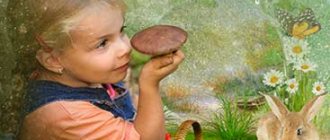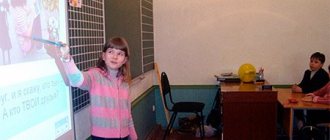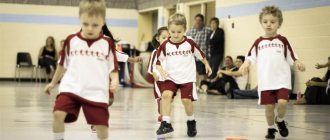More details about the work:
The basis of the individual project on the surrounding world “The Amazing World of Butterflies” is the study of the structure and development cycle of a butterfly in nature, the stages of its transformation from a pupa to a butterfly, and from a butterfly to a caterpillar are explored.
As part of the project activity, a 3rd grade elementary school student conducted personal observations of the transformation of a butterfly from a pupa in a home butterfly garden. In a finished research project on the surrounding world “The Amazing World of Butterflies,” the author studied material about various species of butterflies living in the Tver region, their structure, learned mythical stories about butterflies, observed the transformations of a butterfly, made a conclusion and shared his new knowledge with classmates.
Table of contents
Introduction 1. Legends and stories about butterflies. 2. The structure of a butterfly. 3. Interesting types of butterflies. 4. Home butterfly garden. Conclusion Literature
Introduction
Butterflies are one of the largest orders of insects, including about 140 thousand species.
Butterflies have long attracted human attention. Who among us has not admired the lovely butterflies fluttering from flower to flower? It was not for nothing that the ancients called them flying flowers - they are so beautiful! Butterflies are nature's record holders. In terms of variety of colors, they are unrivaled. Goal: learn how the transformation of a pupa into a butterfly occurs.
Tasks:
- Study material about various types of butterflies living in the Tver region, their structure.
- Learn mythical stories about butterflies.
- Observe the transformations of the butterfly, draw a conclusion and tell your classmates.
Slide captions:
How a butterfly appears
Butterflies are the most beautiful insects. They live wherever there are plants. Butterflies can be large, even gigantic, the size of a bird, and small, the size of a fingernail. Have you ever seen a butterfly? Well, of course we saw it! Do you want to know how these amazing creatures appear?
The female butterfly finds a secluded place on the underside of a leaf and lays many tiny eggs there. Each of them contains a tiny caterpillar that grows day by day. Over time, she gains strength and gnaws through the shell of the egg.
Having got out, the caterpillar immediately begins to eat the leaves. The more she eats, the faster she grows. And one day the old skin becomes too small for her. This skin bursts and the caterpillar crawls out of it, as if from an old dress.
Caterpillars, like butterflies, come in different forms: large and small, bright and inconspicuous. The body of the caterpillar consists of many parts located one after another, like train carriages. With the help of tenacious legs, it deftly crawls along leaves and branches.
Soon the caterpillar becomes very large, stops eating and crawling, settles down comfortably in some cozy place on a leaf or branch and entangles itself with sticky threads. The old skin bursts again, and underneath it appears the body of the caterpillar, covered with new soft skin. It is called a cocoon.
A butterfly grows inside a cocoon. One day she hatches like a chick from an egg. Having got out, the butterfly sits motionless for some time, and then begins to flutter over the flowers.
The butterfly drinks flower nectar with its thin proboscis. The time will come, she will also lay eggs, from which voracious caterpillars will emerge, and then these caterpillars will again turn into beautiful butterflies.
Read also DIY parking clock
Butterfly structure
Butterfly body: head, chest, abdomen, 2 pairs of wings, a pair of antennae, 3 pairs of legs.
Butterflies lay eggs on leaves that serve as food. Larvae emerge from the eggs. The body of a caterpillar has about 2000 muscles. Caterpillars eat plants and molt 4-5 times as they grow.
Swallowtail. Often acts as a symbol of the fight for the conservation of wildlife.
Mother of pearl Titania. It has strong wings, the span of which reaches 7.5 centimeters. This physical makeup allows butterflies to fly both far and high.
Blueberry Alexis . They live mainly in the American tropics. Males are bright blue and have a wingspan of up to 12 cm
Their bright color is given by scales that reflect sunlight.
Black Apollo. Reaches a wingspan of 79 cm; the forewings are white, transparent at the edges, like glass, with black spots; The hind wings are white with two red eyes with a white center, edged with black. Birds usually do not touch the butterfly.
Where do new butterflies come from?
After the butterfly is born from the pupa, a few hours later it looks for a partner. Some species sense their mate from a great distance. After their meeting and mating, the female lays eggs, this is just the first stage of formation, the butterfly has four of them in total.
- Egg.
- Larva.
- Doll.
- Butterfly.
Some butterflies lay up to 1000 eggs per summer. To prevent the eggs from being destroyed, the female hides them: in the soil, under leaves, in special capsules from her glands, under multi-colored scales, and even transfers them to ants for storage.
The last method is the most unusual, it is used by a certain species of butterfly - the blueberry. The ants hide their larvae for the winter in their anthill, and when the caterpillars appear, the ants give them their larvae to be eaten. Ants tolerate such proximity for a reason; they feed on a special liquid that the caterpillars secrete.
Butterfly larva
The larva emerges from the egg, the shell of which it eats as soon as it leaves it. After which the newborn caterpillar begins to eat the leaf. Most often, caterpillars live separately, but some remain a family until they transform into a pupa.
Caterpillar molt
During the process of growing, the caterpillar sheds its skin several times, much like our clothes when we grow out of it. At the same time, the skin from the head does not lose its shape, as if it had taken off a carnival mask, and the skin of the body is crumpled into an accordion.
Doll
When the caterpillar reaches the desired size, the pupation process begins. Outwardly, it looks as if it clung to a branch and froze; over time, the larva will turn into a pupa and will remain in this state until it becomes a butterfly. It is the pupa that freezes, and the larva itself reacts inside it to extraneous movements, but it should not be specifically disturbed.
It remains in the pupal state from a couple of weeks to several months. You cannot break the pupa, as this will prevent the butterfly from flying out earlier. In the cocoon she changes, her wings grow, and her skin changes. If you break its shell ahead of time, the butterfly will die. After the changes are completed, she will destroy the cocoon and climb out.
The first hours of a butterfly's life
Before it can fly, a butterfly must spread its wings. While in the pupa, they were pressed tightly to its body. As soon as they straighten out and dry completely, she will fly in search of her mate and also lay eggs. Giving life to new butterflies.
What do adult butterflies eat?
They no longer “gnaw” leaves, and not because butterflies are more sophisticated creatures than caterpillars, but because they lack a gnawing mouthpart. But they have a proboscis, with which they drink various liquids, almost like we do through a straw. They drink not only nectar, but also water from puddles, the juice of trees and fruits, and some even the blood of buffaloes.
My home butterfly garden
I was born on December 2 and I wanted a piece of summer and a holiday in the middle of winter. That's why they gave me the Butterfly Farm.
All the butterflies were born!!!!
How to care for butterflies
- Feed the day after birth with fruit juice or sugar syrup.
- The wings should be sprayed with water.
- Unfortunately, they don’t live in apartments for long, 3-5 days.
Conclusion
From the list of insects listed in the Red Book, these are butterflies.
Butterflies are suffering greatly from habitat loss. Trapping and collecting is also a reason for their decline.
But not a single collection of dead insects will bring the living joy that a clearing in the forest where wonderful butterflies fly.
On the topic: methodological developments, presentations and notes
Dear Colleagues. This presentation was created based on the book “How a Frog Appears”, author I. Gurina from the series “for kindergarten”. The presentation will allow you to present the material in a more colorful and colorful way.
1. Development of the need to obtain new knowledge about birds. 2. Formation of the desire to protect and care for our little brothers. 3. Formation of cognitive skills: observe, compare, analyze.
Most children experience a strong feeling of jealousy when a newborn arrives in the family. Children under 5 years of age react especially sharply to this situation, since they are still very dependent on.
This summary tells about a trip to Lapland, during which children performed various physical exercises.
The manual is presented in the form of a didactic game that will help children of senior preschool age form an idea of how various living beings are born.
Presentation “How a butterfly appears.”
The comprehensive development and upbringing of children is carried out by various means. One of them is familiarization with nature. Nature is an inexhaustible source of spiritual enrichment. Children are constantly in one form or another.
Ekaterina Startseva
Presentation for children of the senior group “How butterflies appear”
The presentation was used in a lesson on cognition (formation of a holistic picture of the world)
. The theme of the week is “Insects”.
Children clearly became acquainted with this type of insects such as butterflies (thanks to a presentation containing bright photographs and pictures of all stages of butterfly ).
After watching the presentation , the children answered the teacher’s questions and concluded that butterflies look like : fabric scraps, flowers, pieces of the rainbow, candy wrappers, etc. because of their variegated colors. This butterflies very different from other insects. After the conversation, the children and I made butterflies with our own hands from colored cardboard and multi-colored woolen threads.
An exhibition of the pupils' works was organized for their parents.
More detailed information about all types of insects (including butterflies )
The kids will definitely get it at school after finishing kindergarten.
And the goal of kindergarten teachers is to introduce children to insects and teach them to visually distinguish some species from each other.
Read also How to help with headaches
Attached files:
| babochki_lo84u.pptx | 2789.42 KB | Downloads: 45 |
"Butterflies in a flower meadow." Master class for children of the first junior group Spring has come, the brightest and most desirable time of the year, your soul becomes light and joyful. And the children of the first junior group and I give.
Presentation “Pedagogical project for children of the senior group “Journey to the land of kindness and politeness” Pedagogical project for children of the senior group Characteristics of the project Type of project - cognitive - speech By nature - inside the preschool educational institution Po.
Abstract of the NOOD on artistic creativity (application) for children of the second junior group “Butterflies” Synopsis of the NOOD Educational area “Artistic Creativity” (application) Second junior group Topic: “Butterfly” Preliminary work:.
Presentation for children of the senior group “Victory Day” In our kindergarten “Solnyshko” in the village of Novozavedennoye, like in many kindergartens in our country, a thematic week “Spring Day” was held.
Presentation for the holiday script for the Day of March 8 for children of the senior group “March 8 - “Children's TV Channel” This presentation is for the holiday script for “March 8 – “Children's TV Channel”. The presentation will help in holding a festive matinee, as...
Presentation of the project for children of the senior group “My Family” Project for children of the senior group “My Family” Relevance: Family is a source of inspiration, Where adults and children are nearby, In the family from all adversity.
Presentation “Spring” for children of the senior group This presentation for children of the senior group on the topic “Spring has come.” The presentation contains material characterizing the onset of the vein, a.
Consultation “How do icicles appear?” Article “How do icicles appear?” N. A. Sorokina, teacher, Verkhnyaya Salda, Sverdlovsk region. On your life's path, just like...
Presentation “Ecological layout “Forest” for children of the middle-senior group” According to the requirements of the Federal State Educational Standard, the subject-spatial environment must provide the opportunity for communication and joint activities of children and adults.
Read also: Where does barberry grow?






